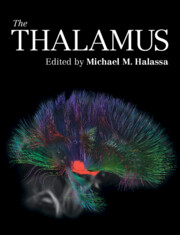Book contents
- The Thalamus
- The Thalamus
- Copyright page
- Contents
- Contributors
- Preface
- Section 1: History
- Section 2: Anatomy
- Section 3: Evolution
- Section 4: Development
- Section 5: Sensory Processing
- Section 6: Motor Control
- Section 7: Cognition
- Section 8: Arousal
- Section 9: Computation
- Chapter 21 A Dynamical Systems Perspective on Thalamic Circuit Function
- Chapter 22 Computational Contributions of the Thalamus to Learning and Memory
- Index
- References
Chapter 22 - Computational Contributions of the Thalamus to Learning and Memory
from Section 9: - Computation
Published online by Cambridge University Press: 12 August 2022
- The Thalamus
- The Thalamus
- Copyright page
- Contents
- Contributors
- Preface
- Section 1: History
- Section 2: Anatomy
- Section 3: Evolution
- Section 4: Development
- Section 5: Sensory Processing
- Section 6: Motor Control
- Section 7: Cognition
- Section 8: Arousal
- Section 9: Computation
- Chapter 21 A Dynamical Systems Perspective on Thalamic Circuit Function
- Chapter 22 Computational Contributions of the Thalamus to Learning and Memory
- Index
- References
Summary
The higher-order thalamus (e.g., the pulvinar) is widely thought to play a critical role in its interactions with the neocortex, but identifying precisely what that role is has been somewhat challenging.Here, we describe how a computational approach to understanding the nature of learning and memory in the neocortex suggests three distinct, well-defined contributions of the thalamus: (1) attention, which is perhaps the most widely discussed function of the pulvinar, is supported by a pooled inhibition dynamic involving the thalamic reticular nucleus; (2) predictive learning, where the pulvinar serves as a kind of screen on which predictions are projected, and a temporal difference between predictions and subsequent outcomes can drive error-driven learning throughout the thalamocortical system; and (3) executive function in the circuits involving the frontal cortex, where the mediodorsal (MD) thalamus is largely similar anatomically to the pulvinar and could thus support similar attentional and predictive learning functions, whereas ventral thalamic nuclei receive inhibitory modulation from the basal ganglia, supporting a gating function to regulate action based on a strong competition of Go versus No Go informed by reinforcement learning.Taken together, these important modulatory and learning contributions of the thalamus suggest that a full computational understanding of the neocortex is significantly incomplete without an integration of the thalamic circuitry.
- Type
- Chapter
- Information
- The Thalamus , pp. 416 - 431Publisher: Cambridge University PressPrint publication year: 2022



